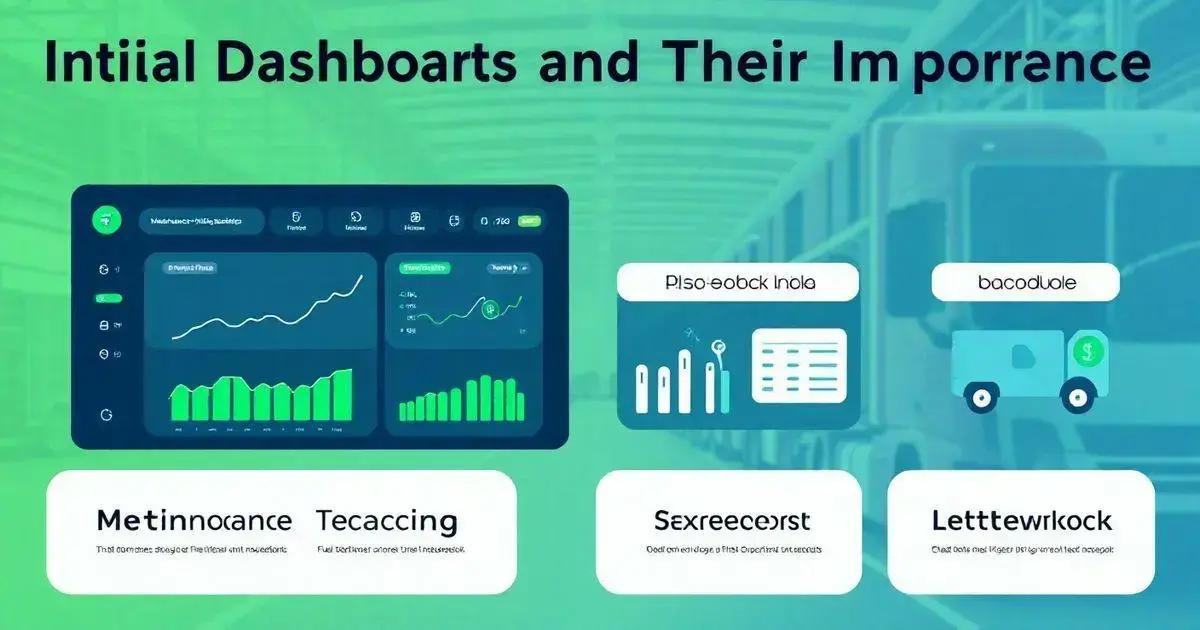10 Features of Fleet Control Worksheet 7.0 You Must Know Leave a comment
The Fleet Control Worksheet 7.0 is a vital resource for fleet managers, featuring Initial Dashboards for performance tracking, Tire and Maintenance Control Systems for vehicle upkeep, Fuel Consumption Analysis for efficiency, and Document Management for organizing essential paperwork. These tools help ensure compliance, enhance safety, and improve overall fleet operations.
The Fleet Control Worksheet 7.0 is a comprehensive tool designed to manage your fleet more efficiently. This worksheet helps track maintenance, fuel consumption, and travel expenses, making it an essential resource for fleet managers. In this article, we will explore the top ten features that make this worksheet a must-have for any logistics operation.
Overview of Fleet Control Worksheet 7.0 Features
The Fleet Control Worksheet 7.0 offers a range of powerful features tailored for effective fleet management. Designed with user-friendliness in mind, it streamlines various tasks associated with vehicle operations, making it an invaluable tool for both small and large fleets.
One of the standout features is the Initial Dashboard, which provides a visual overview of key metrics such as kilometers traveled, fuel consumption, and maintenance costs. This dashboard allows fleet managers to quickly assess the performance of their vehicles and drivers, leading to more informed decision-making.
Additionally, the worksheet includes detailed tracking for Preventive and Corrective Maintenance. Users can schedule maintenance tasks, log completed work, and monitor the costs associated with repairs. This proactive approach helps in extending the lifespan of vehicles and minimizing downtime due to unexpected issues.
Another vital feature is the Travel Control System, which allows for efficient loading and unloading processes. Fleet managers can link cargo management directly to trips, ensuring that all travel expenses are accounted for, from fuel to tolls.
The Tire Control Management system is equally impressive, enabling users to track tire usage, schedule changes based on mileage, and maintain optimal performance across the fleet. This feature is crucial for ensuring safety and efficiency on the road.
Overall, the Fleet Control Worksheet 7.0 combines powerful functionalities with an intuitive interface, making it a go-to solution for fleet managers looking to improve operational efficiency and reduce costs.

Initial Dashboards and Their Importance
The Initial Dashboards in the Fleet Control Worksheet 7.0 are designed to provide a comprehensive overview of your fleet’s performance at a glance. These dashboards play a crucial role in fleet management by consolidating essential data into easily digestible visual formats, allowing managers to monitor metrics without sifting through endless spreadsheets.
One of the key components of these dashboards is the ability to track kilometers run by each driver. This feature not only helps in monitoring driver performance but also assists in identifying patterns that can optimize routes and reduce fuel consumption.
Additionally, the dashboard displays fuel efficiency metrics, such as kilometers per liter and average consumption per vehicle. This information is vital for making data-driven decisions about fuel procurement, vehicle maintenance, and eco-friendly driving practices.
Another important metric displayed is the total cost of maintenance, which includes both preventive and corrective repairs. By having this data readily available, fleet managers can allocate budgets more effectively and prioritize maintenance tasks that require immediate attention.
Moreover, the dashboards facilitate quick reporting on vehicles in transit and delayed documentation. This ensures that compliance and administrative tasks do not fall through the cracks, maintaining the operational integrity of the fleet.
In summary, the Initial Dashboards in the Fleet Control Worksheet 7.0 are integral to effective fleet management. They provide real-time insights that enhance decision-making, streamline operations, and ultimately lead to cost savings and improved fleet performance.
Tire and Maintenance Control Systems
The Tire and Maintenance Control Systems in the Fleet Control Worksheet 7.0 are essential features designed to ensure that your fleet remains safe and efficient on the road. These systems help managers monitor the condition and performance of all vehicles within the fleet, preventing costly breakdowns and improving overall operational efficiency.
With the Tire Control System, fleet managers can track individual tire performance, usage, and replacement schedules. This feature allows for the creation of identification records for each tire, facilitating timely changes based on mileage. The system will provide alerts when tires need to be replaced or rotated, ensuring that vehicles operate at peak safety and performance levels.
Moreover, the Tire Control System allows users to log maintenance actions associated with each tire, such as pressure checks, rotations, and replacements. By maintaining a detailed history of tire management, fleet managers can analyze trends and make informed decisions regarding tire purchasing and maintenance strategies.
In addition to tire management, the Maintenance Control System allows for thorough tracking of both preventive and corrective maintenance activities. Users can schedule maintenance tasks, log completed repairs, and monitor the associated costs for every vehicle in the fleet. This proactive approach not only helps in ensuring compliance with service schedules but also contributes to extending the lifespan of the vehicles.
By integrating these two systems, the Fleet Control Worksheet 7.0 provides a holistic view of fleet health. Managers can quickly assess tire conditions alongside maintenance records to prioritize services and repairs effectively. This ultimately leads to reduced downtime, enhanced safety, and cost savings.
In summary, the Tire and Maintenance Control Systems are vital components of the Fleet Control Worksheet 7.0. They enable fleet managers to maintain optimal vehicle performance and safety, ensuring the fleet operates smoothly and economically.

Fuel Consumption Analysis
The Fuel Consumption Analysis feature in the Fleet Control Worksheet 7.0 is a powerful tool that helps fleet managers monitor and optimize fuel usage across all vehicles.
Fuel consumption is a significant expense in fleet operations, and analyzing this data can lead to substantial cost savings and enhanced efficiency.
At the core of this analysis is the ability to track kilometers per liter (KM/L) for each vehicle. By inputting mileage and fuel purchase data, managers can calculate fuel efficiency on a per-vehicle basis. This enables them to identify which vehicles are performing efficiently and which may require maintenance or adjustments to improve their fuel usage.
The analysis also includes tracking average fuel consumption across the fleet. This aggregated data helps managers spot trends and assess whether fuel expenses are increasing or decreasing over time. Understanding these trends allows for better budgeting and forecasts for future fuel needs.
Additionally, the Fuel Consumption Analysis integrates with the Initial Dashboard, offering a visual representation of fuel usage metrics. Having this information readily available helps managers make quick decisions regarding route optimizations and driving behaviors that could be adjusted to minimize fuel costs.
Furthermore, the worksheet provides insights into the total cost of fuel for each vehicle and the entire fleet. By analyzing this information, fleet managers can identify potential savings, such as switching to more fuel-efficient vehicles or implementing training programs to encourage eco-friendly driving habits among drivers.
In summary, the Fuel Consumption Analysis in the Fleet Control Worksheet 7.0 is an indispensable feature that empowers fleet managers to monitor fuel efficiency, reduce costs, and enhance overall fleet performance. By leveraging this analysis, businesses can achieve significant savings while maintaining their operational effectiveness.
Document Management for Drivers and Vehicles
The Document Management for Drivers and Vehicles feature in the Fleet Control Worksheet 7.0 is crucial for maintaining compliance and ensuring that all necessary documentation is organized and easily accessible.
Managing documents effectively is essential for fleet operations, as it minimizes risks associated with legal compliance and operational inefficiencies.
This feature allows fleet managers to maintain detailed records for each driver, including driver licenses, insurance papers, and medical certificates. By tracking expiration dates and reminders, managers can ensure that all drivers are compliant with legal requirements, thus avoiding potential fines or penalties.
In addition to driver documentation, the system also manages vehicle documents, such as registration papers, insurance policies, and maintenance records. This centralized management ensures that all relevant documents are up-to-date and stored securely, allowing for quick retrieval when needed.
The Document Management feature also includes alerts and notifications for upcoming document expirations. Fleet managers receive timely reminders to renew licenses and insurance, ensuring that compliance is never overlooked. This proactive approach helps avoid operational disruptions and enhances safety on the road.
Furthermore, having all documentation in one place aids in audits and inspections, as everything can be provided efficiently without the need to rummage through multiple locations or files. This organization not only streamlines the management process but also instills confidence that all legal obligations are being met.
In summary, the Document Management for Drivers and Vehicles in the Fleet Control Worksheet 7.0 is an essential tool for ensuring compliance, enhancing safety, and maintaining organized records. By effectively managing this documentation, fleet managers can focus on improving operations and reducing risks associated with non-compliance.
Conclusion
In conclusion, the Fleet Control Worksheet 7.0 is a comprehensive tool that transforms the way fleet managers oversee their operations.
With features like Initial Dashboards, Tire and Maintenance Control Systems, Fuel Consumption Analysis, and Document Management for Drivers and Vehicles, this worksheet not only enhances efficiency but also significantly reduces operational costs.
By leveraging these capabilities, fleet managers can make informed decisions that improve vehicle performance, ensure compliance with regulations, and track essential metrics that contribute to the overall success of their fleet.
Investing in such a robust system is crucial for fleets looking to optimize their operations and maintain a competitive edge in the logistics and transportation industry.
FAQ – Questions about Fleet Control Worksheet 7.0
What is the Fleet Control Worksheet 7.0?
The Fleet Control Worksheet 7.0 is a comprehensive tool designed to help fleet managers track vehicle performance, maintenance, fuel consumption, and driver documentation.
How does the Initial Dashboard benefit fleet managers?
The Initial Dashboard provides a visual overview of key metrics, allowing fleet managers to quickly assess vehicle performance, fuel efficiency, and maintenance costs.
What features does the Tire Control System include?
The Tire Control System tracks individual tire performance, change schedules based on mileage, and records maintenance actions for optimal safety and efficiency.
How can Fuel Consumption Analysis improve fleet operations?
By monitoring fuel efficiency and consumption metrics, fleet managers can identify trends, optimize routes, and implement eco-friendly driving practices to reduce fuel costs.
What type of documents can be managed using this worksheet?
The worksheet allows for management of essential documents for drivers, such as licenses and insurance papers, as well as vehicle documents like registrations and maintenance records.
Is the Fleet Control Worksheet 7.0 suitable for small fleets?
Yes, the Fleet Control Worksheet 7.0 is designed for both small and large fleets, providing scalability and flexibility to meet the needs of various operations.

